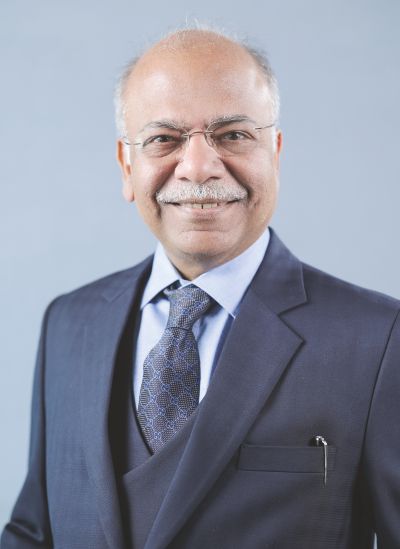“We have to build up our product quality, enhance the customer services, and be more competitive in manufacturing… That’s the way to go!”

Established in 1971, Group Nirmal has a diverse product range and capabilities for the manufacturing of GI wires, aluminum conductors, steel pipes, hot rolled products, and construction steel. The group has recently celebrated the completion of being in business for 50 years, which is a remarkable milestone. In an interview with Wire & Cable India, Mr. Nirmal Saraf, President, Steel Wire Manufacturers’ Association of India (SWMAI) and Managing Director, Nirmal Wires (P) Ltd. – Group Nirmal, talks about the scenario of the steel wire industry, some pertinent challenges, and his message to the fellow industry players.
Wire & Cable India: Share your views on the steel wire sector.
Nirmal Saraf: The steel wire sector is going through a difficult time because steel prices across the world are dropping and they have dropped to a level where the international FOB prices are currently about a hundred dollars per tonne lower than the Indian prices. This is majorly because of the difficulty in importing – the double whammy of the mandatory BIS and the import duty makes importing almost next to impossible or very difficult. Indian manufacturers have kept their prices much above international prices.
The export markets had opened up for India in the post-pandemic period as the world was looking towards India as a supplier. However, presently, due to the high prices of steel in India, the international markets again are being drawn towards China. Although China is also still going through a bad situation due to the impact of the pandemic, the local demand is low and the export share is still higher than the former. The Southeast nations are exporting products like wire rods in a big way. Moreover, they are quite focused on downstream products like wires, which are affecting the export share of the Indian market. Thus, the Indian wire manufacturing industry is in a difficult situation. The major problems are of raw material security and prices of the raw materials.
WCI: Shed some light on the growth potential of the Indian steel wire sector. Also, talk about the major challenges in the sector.
NS: First of all, I would like to talk about the potential of the Indian steel wire segment. We have observed a surge in international buyers looking to build long-term partnerships with Indian companies. This is a very encouraging change. However, as might be expected, nobody would be inclined to pay higher prices. In addition to the price points, another key challenge is meeting the requirements for superlative quality and services. The Indian steel wire industry will have to gear up to being more quality-oriented.
Another important aspect is the cost entailed in the process of converting the wire rods into wires. The Indian wire manufacturing industry is one of the finest globally. Our products are comparable with the products manufactured by leading players in China in terms of cost and quality. We can perform even better than China in this regard. Having said that, there will be a need to procure raw materials at international FOB prices to be able to compete with China and other manufacturing hubs. In fact, it is not the wire industry which is non-competitive with regard to cost but the higher prices determined by the steel industry create inconveniences.
WCI: What are the industry’s expectations from the government in the creation of an ecosystem that could enable the industry to become more competitive?
NS: What is required is that, for any business which is exporting any wire or wire product from the country, the prices of the raw materials should be made available at international FOB prices. What could be the mechanism to be put into place? I don’t discern myself to be competent to recommend any sure-shot mechanism which will work. It’s very simple. The wire manufacturing industry wishes for a level-playing field which can be achieved only if the mentioned parameter is fulfilled. It will also facilitate the growth in the exports of wires and wire products.
WCI: What will be your message for your fellow industry players and manufacturers to deal with the present challenges?
NS: Undoubtedly, the Indian wire industry cannot utilize the full capacity of the wires domestically, which exists. Thus, there is a certain need to increase the export share of the industry. Though it is not implied that the entire spectrum of industry players should export, it holds true for those niche players who focus on service capabilities and product quality. Such players should focus on increasing their export share. In general, the profit margins are dismally low and it’s very difficult for everyone to survive. If things continue like this, I foresee a shake-out happening.
Thus, it also means that we have to build up our product quality, enhance customer services, and be more competitive in manufacturing which is economical or cost-efficient. This will be better for the customers as well as for the respective industry players in terms of services, and quality, which will bring in different opportunities to explore newer markets. That’s the way to go!
Also Read: Wire & Cable India Emagazine Nov-Dec Issue 2022
WCI: How can cost optimization be attained in the industry?
NS: With respect to my outlook on cost-efficiency, I would like to emphasize the importance of advanced technologies and integration of automation in the processes which help in achieving cost-efficiency, reducing rejects, and enhancing product quality. These should be the fundamental transformations.
In today’s day and age, in order to ensure excellent services, businesses need to keep pace with the technologies and digitalize their operations. This is definitely needed to achieve optimum customer satisfaction. If the required services can be on a real-time basis, it will further enhance customer delight. Thus, technology, both in terms of manufacturing operations and services is of paramount importance.




